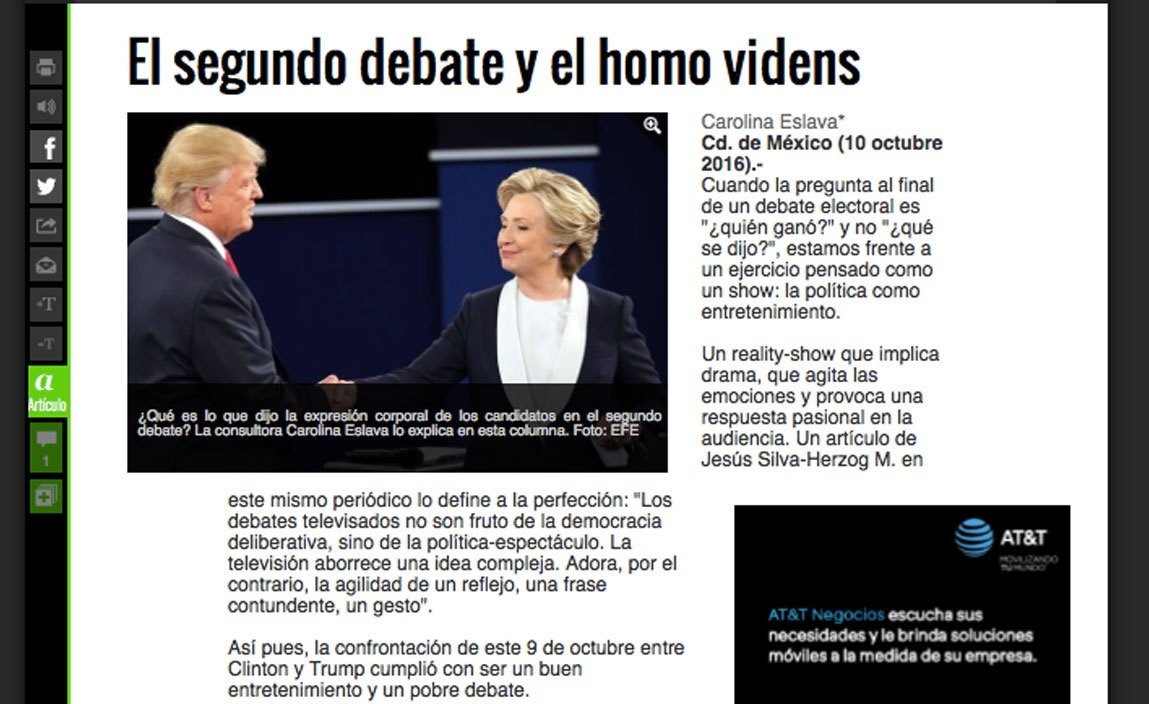
That’s the thought that crosses my mind every time a debate ends. And I must confess that I’m pessimistic: even though the complaint we see on social media or in focus groups is “they just attacked each other, no proposals”, we’re actually asking for the impossible. Because a televised debate isn’t the place to hear proposals. It’s a spectacle that has much more to do with a reality show or an episode of a series (like House of Cards) than with an analysis space. Bad or good? Hmm. Rather, it’s a product of the new times and video politics. I’m sharing my article for Reforma newspaper today.
The Second Debate and the Homo Videns.
When the question at the end of an electoral debate is “who won?” instead of “what was said?”, we are faced with an exercise designed as a show: politics as entertainment. A reality show that involves drama, stirs emotions, and provokes a passionate response from the audience. An article by Jesús Silva-Herzog M. in this same newspaper defines it perfectly: “Televised debates are not the result of deliberative democracy but of political spectacle. Television abhors a complex idea. It adores, on the other hand, the agility of a reflex, a forceful phrase, a gesture.” Thus, the confrontation on October 9th between Clinton and Trump fulfilled being good entertainment and a poor debate.
It has been almost 18 years since I started working with candidates for elective positions to develop and refine their verbal and non-verbal communication skills. Debate preparation is a fundamental exercise in a campaign because these moments attract the maximum attention of news media, social media, opinion leaders, and to a lesser extent, some voters. The reason is that these are spaces where citizens believe they can see the candidates live, without intermediaries and without filters, to get an idea of how they really are and choose the one who gives them the most confidence. This phenomenon is known as the personalization of politics: we no longer vote for a party or a platform, but for a person. Therefore, it is essential that candidates who aspire to inspire confidence among their potential voters understand and follow the rules of televised debates.

The first thing we judge when watching a debate is the initial impression, which shows us the participants’ mood as they enter the stage. Their way of walking allows us to intuit their emotional expression and character traits such as sadness, joy, haughtiness, or anger. Studies by Momtepare, Goldstein, and Clausen have concluded that it is possible to easily identify emotions and character traits by observing a person’s walking style. In tonight’s debate, Donald Trump shows dejection and concern by changing his traditional confident walking style (with an open chest, long strides, and a swinging arm) to slower steps, slumped shoulders, and a sunken chest. Hillary Clinton, on the other hand, arrives with a firm step, at a measured pace, and with an expanded chest. This aspect, as well as the handling of hand and arm gestures, can and should be analyzed, nuanced, corrected, or reinforced. The same goes for the way they are positioned on stage: will they be seated or standing? Will there be a fixed or handheld microphone? At what height should the lectern be placed to avoid blocking their face too much? All these details should be known by the team preparing the candidates because an exaggerated or unplanned gesture can distract their attention and become the meme of the moment.
Another topic that is carefully planned is the attire, makeup, and hairstyle of the participant, because as Nixon advised future candidates after that first famous debate in 1960: “Let them put makeup on you even if you hate it. I hate it, but being defeated once for not doing it, I would never make the same mistake again.”
While there are many elements that can and should be reviewed and considered from the perspective of the electorate, there are aspects of facial expression that, being “an external manifestation of the candidate’s thoughts and psychic states” (Sillamy), are difficult to alter. To analyze these microgestures, for example, the tool called Facial Action Coding System (FACS) developed by Paul Ekman is used. In the case of the initial gaze of both candidates, we observe that it was completely opposite: while Trump appears with his eyes tightly closed and squeezed, literally reflecting “not wanting to see”, Hillary’s gaze is open, with bright eyes and showing a large part of the sclera (the white part of the eye) that inspires much greater confidence.
Another unconscious expression that is detected both in the initial moments of the debate and when Trump is asked about his sexual statements is contained anger: the lips pressed together that reduce the mouth to a closed line. This is different from his usual “duck face” (with the orbicular muscle tight), which is a mixture of disdain and arrogance. In the case of Hillary, her weaker microexpressions were when Trump accuses her of lying and tells her that there is a big difference between her and Lincoln. At that moment, her mouth draws a tough gesture that tries to transform into a smile that looks fake. Her gaze also hardens as she squints, but she tries to quickly compose herself.
We could analyze frame by frame this second face-off between the Republican and the Democrat to determine who “won” the debate in terms of overall image. However, in summary, we saw Trump… being Trump and regaining his usual confidence from the second third of the debate, while Hillary was more measured and empathetic but slightly faltered and missed the opportunity to “finish off” her opponent. And yet, voters of one or the other will perceive, in the same gesture, a totally favorable interpretation towards their candidate and absolutely negative towards their opponent. That’s why I believe, like Sartori, that “the image also lies.” Finally, homo videns.